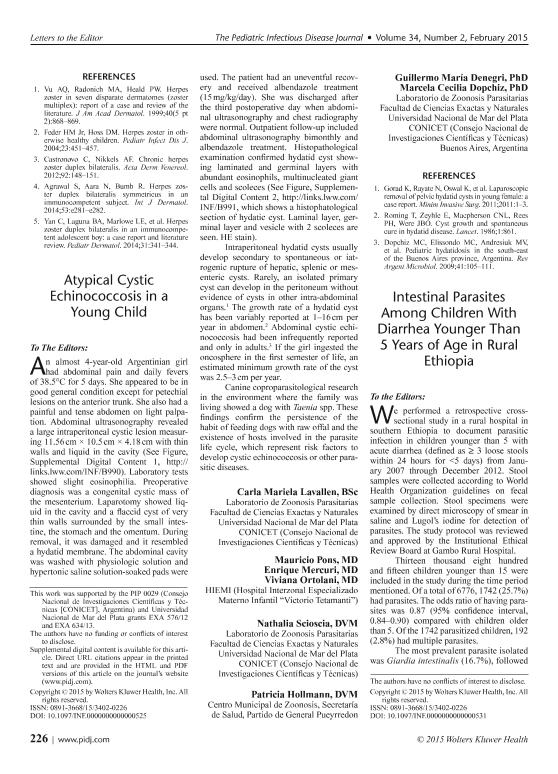Artículo
Atypical cystic echinococcosis in a young child
Lavallén, Carla Mariela ; Pons, Mauricio; Mercuri, Enrique; Ortolani, Viviana; Scioscia, Nathalia Paula
; Pons, Mauricio; Mercuri, Enrique; Ortolani, Viviana; Scioscia, Nathalia Paula ; Hollmann, Patricia; Denegri, Guillermo Maria
; Hollmann, Patricia; Denegri, Guillermo Maria ; Dopchiz, Marcela Cecilia
; Dopchiz, Marcela Cecilia
 ; Pons, Mauricio; Mercuri, Enrique; Ortolani, Viviana; Scioscia, Nathalia Paula
; Pons, Mauricio; Mercuri, Enrique; Ortolani, Viviana; Scioscia, Nathalia Paula ; Hollmann, Patricia; Denegri, Guillermo Maria
; Hollmann, Patricia; Denegri, Guillermo Maria ; Dopchiz, Marcela Cecilia
; Dopchiz, Marcela Cecilia
Fecha de publicación:
02/2015
Editorial:
Lippincott Williams
Revista:
Pediatric Infectious Disease Journal
ISSN:
0891-3668
Idioma:
Inglés
Tipo de recurso:
Artículo publicado
Clasificación temática:
Resumen
An almost four year old Argentinian girl had abdominal pain and daily fevers of 38.5°C for 5 days. She appeared to be in good general condition except for petechial lesions on the anterior trunk. She also had a painful and tense abdomen on light palpation. Abdominal ultrasonography revealed a large intraperitoneal cystic lesion measuring 11.56 cm × 10.5 cm x 4.18 cm with thin walls and liquid in the cavity (See Figure, Supplemental Digital Content 1). Laboratory tests showed slight eosinophilia. Preoperative diagnosis was a congenital cystic mass of the mesenterium. Laparotomy showed liquid in the cavity and a flaccid cyst of very thin walls surrounded by the small intestine, the stomach and the omentum. During removal it was damaged and it resembled a hydatid membrane. The abdominal cavity was washed with physiologic solution and hypertonic saline solution-soaked pads were used. The patient had an uneventful recovery and received albendazole<br />treatment (15 mg/kg/day). She was discharged after the 3rd postoperative day when abdominal ultrasonography and chest radiography were normal. Outpatient follow-up included abdominal ultrasonography bimonthly and albendazole treatment. Histopathological examination confirmed hydatid cyst showing laminated and germinal layers with abundant eosinophils, multinucleated giant<br />cells and scoleces (See Figure, Supplemental Digital Content 2, which shows a histophatological section of hydatic cyst. Laminal layer, germinal layer and vesicle with two scoleces are seen. HE stain).<br />Intraperitoneal hydatid cysts usually develop secondary to spontaneous or iatrogenic rupture of hepatic, splenic, or mesenteric cysts. Rarely an isolated primary cyst can develop in the peritoneum without evidence of cysts in other intra-abdominal organs 1. The growth rate of a hydatid cyst has been variably reported at 1-16 cm per year in abdomen 2. Abdominal cystic echinococcosis had been infrequently reported and only in adults 3. If the girl ingested the oncosphere in the first semester of life, an estimated minimum growth rate of the cyst was 2.5-3 cm per year.<br />Canine coproparasitological research in the environment where the family was living showed a dog with Taenia sp. These findings confirm the persistence of the habit of feeding dogs with raw offal and the existence of hosts involved in the parasite life cycle, which represent risk factors to develop cystic echinococcosis or other parasitic diseases.<br />
Palabras clave:
Intraperitoneal Hydatid Cyst
,
Surgery
,
Canine
,
Zoonotic Parasites
Archivos asociados
Licencia
Identificadores
Colecciones
Articulos(CCT - MAR DEL PLATA)
Articulos de CTRO.CIENTIFICO TECNOL.CONICET - MAR DEL PLATA
Articulos de CTRO.CIENTIFICO TECNOL.CONICET - MAR DEL PLATA
Citación
Lavallén, Carla Mariela; Pons, Mauricio; Mercuri, Enrique; Ortolani, Viviana; Scioscia, Nathalia Paula; et al.; Atypical cystic echinococcosis in a young child; Lippincott Williams; Pediatric Infectious Disease Journal; 34; 2; 2-2015; 226-226
Compartir
Altmétricas



